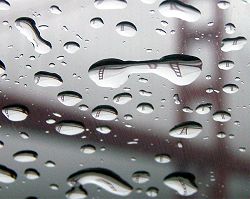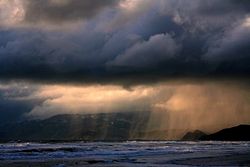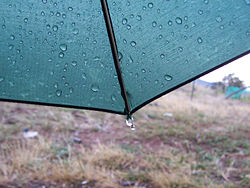Rain
2008/9 Schools Wikipedia Selection. Related subjects: Climate and the Weather
Rain is a type of precipitation, a product of the condensation of atmospheric water vapor that is released on the Earth's surface. It forms when separate drops of water fall to the Earth from clouds. Not all rain reaches the surface; some of it evaporates while falling through dry air. When none of it reaches the ground, it is called virga, a phenomenon often seen in hot, dry desert regions. Rain is the primary source of fresh water for most areas of the world, providing suitable conditions for diverse ecosystems, as well as water for hydroelectric power plants and crop irrigation. The METAR code for rain is RA.
Formation
Rain plays a role in the hydrologic cycle in which moisture from the oceans evaporates, condenses into drops, precipitates (falls) from the sky, and eventually returns to the ocean via rivers and streams to repeat the cycle again. The water vapor from plant respiration also contributes to the moisture in the atmosphere.
A major scientific explanation of how rain forms and falls is called the Bergeron process. More recent research points to the influence of Cloud condensation nuclei released as the result of biological processes.
Human influence

The fine particulate matter produced by car exhaust and other human sources of pollution form cloud condensation nuclei, leads to the production of clouds and increases the likelihood of rain. As commuters and commercial traffic cause pollution to build up over the course of the week, the likelihood of rain increases: it peaks by Saturday, after five days of weekday pollution has been built up. In heavily populated areas that are near the coast, such as the United States' Eastern Seaboard, the effect can be dramatic: there is a 22% higher chance of rain on Saturdays than on Mondays.
Classifying the amount of rain
When classified according to amount of precipitation, rain can be divided into:
- Very light rain — when the precipitation rate is < 0.25 mm/hour
- Light rain — when the precipitation rate is between 0.25 mm/hour - 1.0 mm/hour
- Moderate rain — when the precipitation rate is between 1.0 mm/hour - 4.0 mm/hour
- Heavy rain — when the precipitation rate is between 4.0 mm/hour - 16.0 mm/hour
- Very heavy rain — when the precipitation rate is between 16.0 mm/hour - 50 mm/hour
- Extreme rain — when the precipitation rate is > 50.0 mm/hour
Properties
Falling raindrops are often depicted in popular culture as "teardrop-shaped" — round at the bottom and narrowing towards the top — but this is incorrect. Only drops of water dripping from some sources are tear-shaped at the moment of formation. Small raindrops are nearly spherical. Larger ones become increasingly flattened on the bottom, like hamburger buns; very large ones are shaped like parachutes. The shape of raindrops was studied by Philipp Lenard in 1898. He found that small raindrops (less than about 2 mm diameter) are approximately spherical. As they get larger (to about 5 mm diameter) they become more doughnut shaped. Beyond about 5 mm they become unstable and fragment. On average, raindrops are 1 to 2 mm in diameter. The biggest raindrops on Earth were recorded over Brazil and the Marshall Islands in 2004 — some of them were as large as 10 mm. The large size is explained by condensation on large smoke particles or by collisions between drops in small regions with particularly high content of liquid water.
Raindrops impact at their terminal velocity, which is greater for larger drops. At sea level and without wind, 0.5 mm drizzle impacts at about 2 m/s, while large 5 mm drops impact at around 9 m/s. The sound of raindrops hitting water is caused by bubbles of air oscillating underwater. See droplet's sound.
Generally, rain has a pH slightly under 6. This is because atmospheric carbon dioxide dissolves in the droplet to form minute quantities of carbonic acid, which then partially dissociates, lowering the pH. In some desert areas, airborne dust contains enough calcium carbonate to counter the natural acidity of precipitation, and rainfall can be neutral or even alkaline. Rain below pH 5.6 is considered acid rain.
Effect on agriculture
Precipitation, especially rain, has a dramatic effect on agriculture. All plants need at least some water to survive, therefore rain (being the most effective means of watering) is important to agriculture. While a regular rain pattern is usually vital to healthy plants, too much or too little rainfall can be harmful, even devastating to crops. Drought can kill crops in massive numbers, while overly wet weather can cause disease and harmful fungus. Plants need varying amounts of rainfall to survive. For example, cacti need small amounts of water while tropical plants may need up to hundreds of inches of rain per year to survive.
Agriculture of all nations at least to some extent is dependent on rain. Indian agriculture, for example, (which accounts for 25 percent of the GDP and employs 70 percent of the nation's population) is heavily dependent on the rains, especially crops like cotton, rice, oilseeds and coarse grains. A delay of a few days in the arrival of the monsoon can, and does, badly affect the economy, as evidenced in the numerous droughts in India in the 90s.
Culture
Cultural attitudes towards rain differ across the world. In the largely temperate Europe, rain metaphorically has a sad and negative connotation — reflected in children's rhymes like Rain Rain Go Away — in contrast to the bright and happy sun. Though the traditional notion of rain in the Western World is negative, rain can also bring joy, as some consider it to be soothing or enjoy the aesthetic appeal of it. In dry places, such as parts of Africa, Australia, India, and the Middle East, rain is greeted with euphoria. (In Botswana, the Setswana word for rain, "pula," is used as the name of the national currency, in recognition of the economic importance of rain in this desert country.)
Several cultures have developed means of dealing with rain and have developed numerous protection devices such as umbrellas and raincoats, and diversion devices such as gutters and storm drains that lead rains to sewers. Many people also prefer to stay inside on rainy days, especially in tropical climates where rain is usually accompanied by thunderstorms or is extremely heavy (as in a monsoon). Rain may be harvested, though rainwater is rarely pure (as acid rain occurs naturally), or used as greywater. Excessive rain, particularly after a dry period that has hardened the soil so that it cannot absorb water, can cause floods.
Many people find the scent during and immediately after rain especially pleasant or distinctive. The source of this scent is petrichor, an oil produced by plants, then absorbed by rocks and soil, and later released into the air during rainfall. Light or heavy rain is sometimes seen as romantic.
World
Europe
In the United Kingdom most rain is driven into the country by the south-western trade winds following the warm gulf stream currents. Areas along the western coasts can receive between 1000 mm (40 inches, at sea-level) and 2500 mm (100 inches, on the mountains) of rain per year. However, what is less well known is that the eastern and southern half of the country is much drier, with the south east having a lower rainfall average than Jerusalem and Beirut at between 450 and 600 mm per year.
Meanwhile, Bergen in Norway is one of the more famous European rain-cities with its yearly precipitation of 2250 mm (88 inches) on average.
North America
One city that is known for rain is Seattle, Washington. Rain is common in the winter, but mostly the climate is cloudy with little rain. Seattle's average rainfall is 942 mm (37.1 inches) per year, less than New York City's 1173 mm (46.2 inches), but Seattle has 201 cloudy days per year, compared to 152 in New York. Seattle's neighbour to the south, Portland, Oregon, gets more rain with an average of 45 inches (1,100 mm) a year. However, it should be noted that Seattle lies in the rain shadow of the nearby Olympic Mountains, with some locations on the windward sides of the mountains receiving close to 130 inches per year. The wettest city in the continental United States is Mobile, Alabama, which average 67 inches of rainfall per year. Ketchikan Alaska and other locations in the temperate rainforest of southeast Alaska get an average of 160 inches of rain a year, sometimes receiving over 200 inches in a year.
Australia
Although Australia is the world's driest continent, Mount Bellenden Ker in the north-east of the country records an average of 8000 mm (315 inches) per year, with over 12000 mm (472 inches) of rain recorded in the year 2000.
Melbourne has a similar reputation to Vancouver's. In the popular imagination it is thought of as being much rainier than Sydney; however, Sydney receives an average of 1094 mm (43.1 inches) of rain per year compared to Melbourne's 544 mm (21.4 inches). Sydney, meanwhile, experiences 53 fewer overcast days per year than Melbourne.
Asia
Cherrapunji, situated on the southern slopes of the Eastern Himalaya in Shillong, India is one of the wettest places on Earth, with an average annual rainfall of 11,430 mm (450 in). The highest recorded rainfall in a single year was 22,987 mm (904.9 inches) in 1861.
Mythology
The Ancient Greeks believed that rain was a sign of the gods' anger towards them. They thought that it symbolised drowning and frustration as it often disturbed what they were doing.




